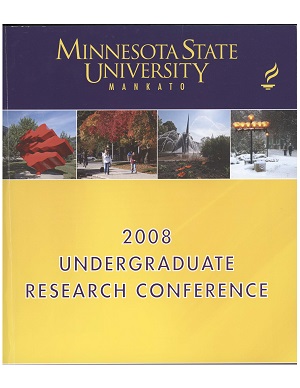Ms., Mrs., Mr.: Gendered Language in Wedding Invitations
Location
CSU 204
Start Date
21-4-2008 10:00 AM
End Date
21-4-2008 12:00 PM
Student's Major
Communication Studies
Student's College
Arts and Humanities
Mentor's Name
Rachel Droogsma
Mentor's Department
Communication Studies
Mentor's College
Arts and Humanities
Description
According to the Sapir-Whorf Hypothesis, language has the ability to shape individuals' viewpoints, values, and ideas about other people and events. People have different attitudes about gender and what they think is the norm, and these differences are likely shaped by, and reflected in, the language they use to label gender and gender roles. This study gathers information about gendered language, usage, or language that designates gender such as gendered titles and pronouns, in wedding invitations in order to determine peoples' attitudes about gender. Wedding invitations have been chosen as a text because they often display more traditional gendered language despite the fact that society as a whole now tends to disfavor gendered language in everyday speech. The researcher possesses a large quantity of wedding invitations due to his membership in a music group that plays at many wedding ceremonies; these invitations span the last decade and a random sample will be drawn. As in most qualitative research of this kind, the number of texts samples will depend on a "critical threshold" of interpretation; this is reached when analysis of texts begin to become redundant. The wedding invitations will be analyzed using qualitative content analysis, which is a form of rhetorical criticism similar to cluster analysis that draws out of the data frequently used terms as well as the terms or ideas that cluster around those main terms, in order to examine the rhetor's underlying worldviews and values. The study will look for gendered language in participants' titles of address and elsewhere. Along with detecting gendered language, the study will analyze the placement of the gendered language and attempt to interpret what the presence of gendered language indicates about common attitudes of gender. The results of this study can potentially indicate cultural views about gender and gender norms and presumably what married couples are supposed to create through marriage.
Ms., Mrs., Mr.: Gendered Language in Wedding Invitations
CSU 204
According to the Sapir-Whorf Hypothesis, language has the ability to shape individuals' viewpoints, values, and ideas about other people and events. People have different attitudes about gender and what they think is the norm, and these differences are likely shaped by, and reflected in, the language they use to label gender and gender roles. This study gathers information about gendered language, usage, or language that designates gender such as gendered titles and pronouns, in wedding invitations in order to determine peoples' attitudes about gender. Wedding invitations have been chosen as a text because they often display more traditional gendered language despite the fact that society as a whole now tends to disfavor gendered language in everyday speech. The researcher possesses a large quantity of wedding invitations due to his membership in a music group that plays at many wedding ceremonies; these invitations span the last decade and a random sample will be drawn. As in most qualitative research of this kind, the number of texts samples will depend on a "critical threshold" of interpretation; this is reached when analysis of texts begin to become redundant. The wedding invitations will be analyzed using qualitative content analysis, which is a form of rhetorical criticism similar to cluster analysis that draws out of the data frequently used terms as well as the terms or ideas that cluster around those main terms, in order to examine the rhetor's underlying worldviews and values. The study will look for gendered language in participants' titles of address and elsewhere. Along with detecting gendered language, the study will analyze the placement of the gendered language and attempt to interpret what the presence of gendered language indicates about common attitudes of gender. The results of this study can potentially indicate cultural views about gender and gender norms and presumably what married couples are supposed to create through marriage.
Recommended Citation
Riederer, Tavis. "Ms., Mrs., Mr.: Gendered Language in Wedding Invitations." Undergraduate Research Symposium, Mankato, MN, April 21, 2008.
https://cornerstone.lib.mnsu.edu/urs/2008/oral-session-05/4



